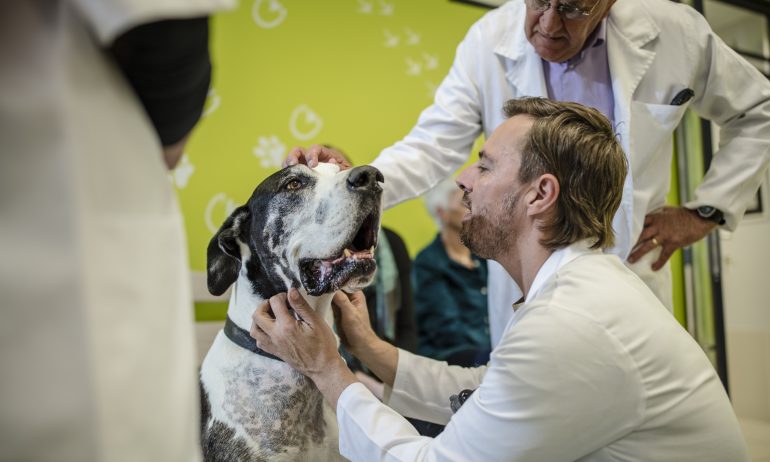Does Pet Insurance Cover Surgery?

Many, or all, of the products featured on this page are from our advertising partners who compensate us when you take certain actions on our website or click to take an action on their website. However, this does not influence our evaluations. Our opinions are our own. Here is a list of our partners and here's how we make money.
Pet insurance policies typically cover surgeries that are necessary to heal a medical condition or save your pet's life.
Surgery coverage is usually part of an accident and illness insurance plan.
Routine procedures and surgeries for pre-existing conditions are generally not covered.
Your pet is part of the family, and you'd do anything to keep them healthy and happy. But what happens if they need surgery? Will your pet insurance cover the cost? The answer isn’t always straightforward. Here's when pet insurance typically covers surgery and when it doesn’t.
Does pet insurance cover surgery?
Pet insurance can help pay for surgery if your pet gets hurt or sick. This could include surgeries for broken bones, cancer, objects stuck in their stomach, emergencies, ligament problems or some dental issues. If you buy a wellness plan, you may also have coverage for spaying or neutering.
But pet insurance almost never covers surgeries for pre-existing conditions or elective procedures like tail docking or dew claw removal.
Surgical procedures that pet insurance typically covers
Pet insurance policies typically pay for surgical procedures needed to treat an accident or illness. Depending on your policy, this may include:
Cancer treatments like tumor removal.
Removing objects like rocks, toys or sticks that pets accidentally swallow.
Emergency surgeries for life-threatening situations like bloat or internal bleeding.
Dental surgeries like tooth extractions or root canals caused by an illness or accident.
Surgeries for ruptured knee ligaments or hip dysplasia.
Procedures to treat hereditary and congenital conditions such as luxating patellas.
Many pet insurance companies won't cover certain orthopedic issues for the first several months of your policy. Also, if your pet had a bilateral issue like hip dysplasia on one side of their body before you bought their policy, it may be considered a pre-existing condition if it happens on the other side of their body. Pet insurance generally won’t pay to treat pre-existing conditions.
Surgical procedures that pet insurance typically won’t cover
Pet insurance plans usually have a wide range of exclusions and limitations. Accident and illness plans often won’t cover:
Surgeries to treat conditions your pet had before coverage began.
Cosmetic or elective procedures like ear cropping, tail docking, gastropexy (a surgery to prevent bloat), microchipping, declawing or dew claw removal.
Breeding-related procedures like cesarean sections, spaying or neutering.
Some pet insurance companies offer preventive care plans that will cover some of the procedures above (such as spaying, neutering, microchipping or gastropexy).
» MORE: What does pet insurance cover?
Many pet insurers will cover curable pre-existing conditions like vomiting and gastrointestinal issues if your pet has been treatment- and symptom-free for a certain period of time. Check with your insurer to see if any of your pet’s previous conditions are considered curable.
Common pet surgical procedures
While pet insurance doesn't cover every type of surgery, it can help you save money on many procedures caused by accidents or illnesses. Here’s a look at common pet surgical procedures and whether insurance generally covers them.
Pet surgery | Generally covered by insurance? |
|---|---|
ACL or CCL repair | Yes. |
Amputation | Yes. |
Cancer surgery | Yes. |
Cataracts | Yes. |
Fractures and dislocation repair | Yes. |
Hip dysplasia | Usually. |
Intestinal obstruction due to foreign body | Yes. |
Mass or tumor removal | Yes. |
Skin lacerations | Yes. |
Spay or neuter | No, except with some wellness plans. |
How does surgery coverage work?
Surgery coverage is usually a standard part of accident and illness coverage. So if your pet needs surgery for a broken leg, tumor or cataracts — and it’s not related to a pre-existing condition — insurance will likely cover it.
However, having pet insurance doesn’t guarantee that all veterinary bills will be paid. These policies typically have a deductible, a reimbursement rate and a maximum coverage limit per year or per incident. Depending on your insurer, you may also be responsible for paying exam fees related to the surgery.
The deductible is the amount you must pay before your pet insurer will begin covering your vet bills. Most insurers charge an annual deductible, but some assess deductibles per condition. Learn more about pet insurance deductibles.
The reimbursement rate is the percentage of your vet bills your pet insurer will cover once you’ve reached your deductible. The percentage you cover is known as a copayment.
The maximum coverage limit is the total amount your pet insurer will pay per year or per incident.
Say you have a pet insurance plan with a $500 deductible, 80% reimbursement rate and $10,000 annual limit. Your pet needs surgery to remove a tumor, which will cost $3,000.
First, you'll need to pay the $500 deductible out of pocket. After that, your insurance will cover 80% of the remaining $2,500, which comes out to $2,000. You'll be responsible for the remaining 20%, which comes out to $500.
So in total, you'll pay $1,000 for the surgery ($500 deductible + $500 coinsurance), and your insurance will cover $2,000. If your pet needs follow-up care later in the year, you'll have $8,000 left of your annual limit to cover any additional medical expenses.
How to file a claim for surgery costs
There are two ways to file a pet surgery claim.
The first way is with direct billing. With this option, you won't have to pay your insurer’s part of the bill out of pocket. Instead, your pet insurance company will pay your vet directly.
Direct billing isn’t that common. Pets Best, Healthy Paws and Trupanion are some of the only pet insurance companies that will pay your vet directly. Your vet must also be willing to accept payments directly from providers.
The more traditional way to file a pet insurance claim for surgery is to pay the full amount upfront and then submit the claim to your insurance company for reimbursement. To do this, you'll generally need to fill out your insurance company’s claim form and provide a copy of the itemized receipt or invoice from your vet.
Your insurance company will review your claim to make sure it meets the terms of your policy. If everything checks out, your insurer will reimburse you the covered amount, minus any deductible or copay.
Can you buy pet insurance before surgery?
Yes, you can buy pet insurance before your pet needs surgery, but that doesn’t mean your policy will pay for the procedure.
Pet insurance doesn’t cover pre-existing conditions, so any medical condition your pet was diagnosed with before you bought the policy won't be covered.
Pet insurance plans also have waiting periods, the length of time between when you buy your plan and when insurance will start covering eligible treatments. Common waiting periods are 14 days for illness coverage and 48 hours for accident coverage.
How top pet insurance companies cover surgery
To give you an idea of how different pet insurance companies cover surgery, we looked at three insurers from our list of the best pet insurance companies.
Embrace surgery coverage
Embrace's standard policy covers exams, treatment, hospitalization and surgery for injuries and illnesses, including cancer. But you’ll need to add a wellness plan to get coverage for spaying and neutering. Embrace won’t cover surgeries arising from pre-existing conditions, fighting, racing or mistreatment.
Figo surgery coverage
Figo pet insurance covers surgeries, prescription medications and diagnostic testing for accidents and illnesses. But pre-existing conditions aren’t covered unless they've been cured and the pet is symptom-free for at least 12 months. Figo has wellness plans for things like vaccines, routine exams, dental cleaning, and spay or neuter surgery.
Pets Best surgery coverage
Pets Best’s surgery coverage is included in its accident and illness plan. The policy can also cover pre- and post-surgical care like diagnostic tests, prescription medication and physical rehabilitation. Add a wellness plan if you want coverage for spay or neuter surgery.


